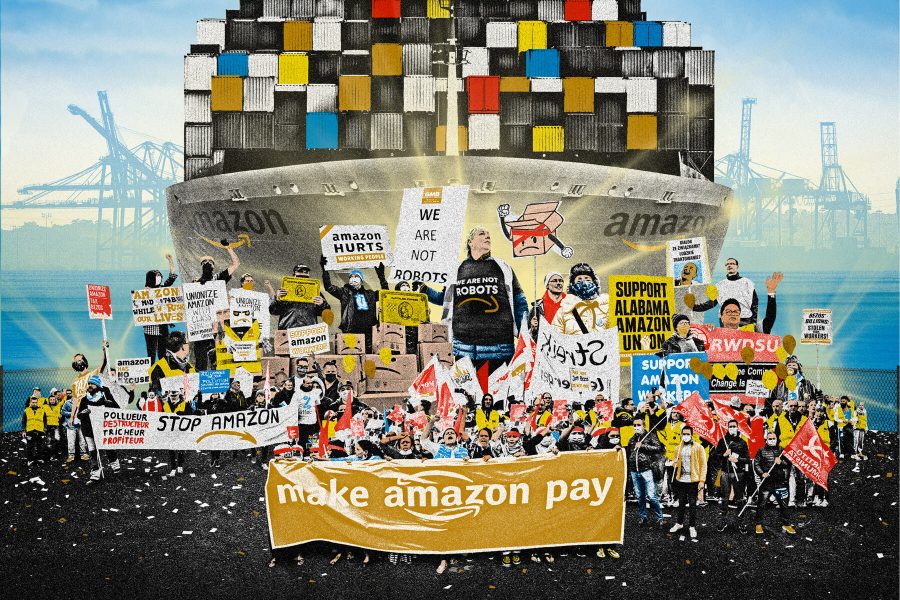Bessemer was just the beginning. Amazon workers from Italy to India are uniting to form a global movement that may have found Jeff Bezos’s Achilles heel.
The union drive at Amazon’s 885,000-square-foot warehouse in Bessemer, Alabama, failed. But the historic campaign nabbed global headlines and added fuel to ongoing workers’ revolts across the world.
Strikes by Amazon workers in Italy, Germany and India are coalescing into an international struggle against the world’s fourth-most valuable company and its grueling working conditions and intensive surveillance.
Since the dawn of capitalism, bosses have found innovations to oversee and extract more work from the overstressed bodies of their labor force. But Amazon’s minute surveillance of workers — who, at the Bessemer facility, are mostly Black and women — would make the Stasi blush. At the company’s warehouses, workers use hand-held devices that track their every move and assess their speed and accuracy. What is particularly novel about Amazon, as Joe DeManuelle-Hall writes in the movement publication Labor Notes, is how it brings together productivity innovations to create a regime of terror on the shop floor, with pressures that infamously force workers to pee in bottles rather than take breaks.
Amazon, along with Walmart, its fiercest competitor, is the 21st century’s quintessential factory floor.
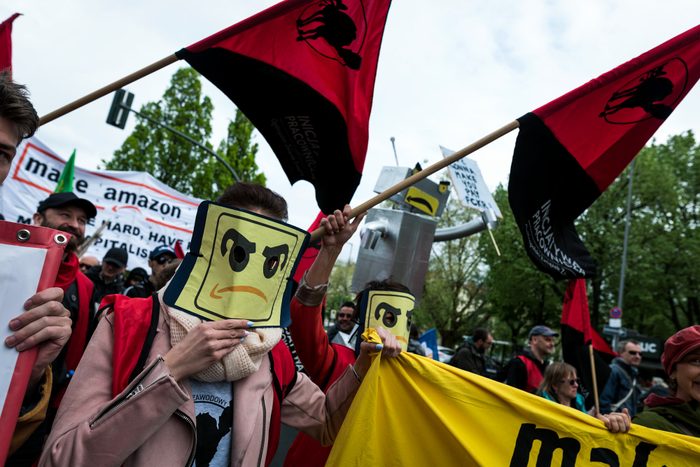
Blue-collar Amazon workers keep the cascade of goods around the world flowing; they are the muscle that fulfills consumer desire as it barrels down the arterial lanes of Amazon.com. These ground logistics leave behind more than just pixel dust, wreaking devastating environmental havoc: a carbon footprint in the millions of metric tons, rivaling roughly the annual emissions of Norway.
Through the alchemy of supply chain management, the goods sold through Amazon — everything from PlayStations to yoga pants — travel via cargo vans, airplanes and ships across a global infrastructure of roads, skies and oceans on their voyage to customers’ doorsteps.
Like the 19th-century workers forging steel for Andrew Carnegie, refining oil for John D. Rockefeller or building cars for Henry Ford, Amazon workers are up against a titan of industry: Jeff Bezos, the wealthiest man in the world. Bezos took advantage of the new and unregulated terrain of e-commerce to behave as ruthlessly as those titans of yore.
“Jeff Bezos and his crew of techies and quants simply did what robber barons have always done: Raise, spend and sometimes lose other people’s money, dodge taxes, swindle suppliers and avoid unions,” Kim Moody writes in the essay collection, The Cost of Free Shipping: Amazon in the Global Economy.
Now, understanding how critical they are to fulfilling Amazon’s promise of just-in-time delivery, Amazon workers are organizing for control of their workplaces. Their indispensability is their leverage to negotiate safer working conditions, dignity on the job and pay commensurate with the value they’ve produced: $21.33 billion in net income for Amazon in 2020 (a $9.7 billion increase during the pandemic) and $67.9 billion more for Bezos’ already obscene oodles of wealth.
And the spark ignited in Alabama is catching on. Perry Connelly, a 58-year-old Bessemer worker, says the union campaign received an outpouring of support from around the world. He realized that, by challenging Amazon in the South — a regional stronghold of anti-union fortification — “we’ll be making a huge difference not only in Alabama, but globally.”
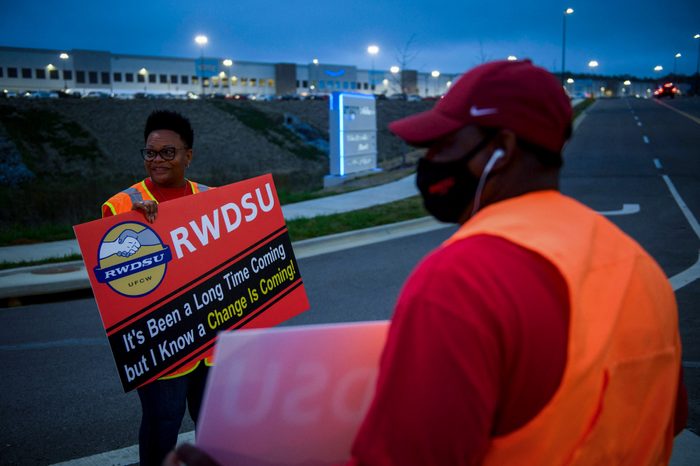
A Global Resistance
Workers around the world — from Colombia to Nigeria to Myanmar — have expressed solidarity with Amazon’s workers in Alabama. When Italy’s largest labor federation, Confederazione Generale Italiana del Lavoro (CGIL), went on strike March 22 at 15 Amazon warehouses (alongside other unions), workers carried a banner that read, “From Piacenza to Alabama — One Big Union.”
“Amazon workers in Europe understand that an organized workforce in the United States would be a gamechanger,” says Christy Hoffman, general secretary of UNI Global Union, which has coordinated international Amazon worker actions.
Of Amazon’s estimated 1,538 facilities of all types worldwide, 290 are in Europe, 294 are in India, and 887 are in North America. The bulk of those are in the United States — with more on the way as Amazon expands into urban areas. (Amazon also has a smaller presence in Brazil, Egypt, Kuwait, Saudi Arabia, the United Arab Emirates and Singapore.)
“The campaign in Bessemer has grabbed the globe’s imagination,” Hoffman says. “It is an inspiration to see workers in Amazon’s home country, in a hostile environment, stand up for change.”
In the United States, labor law largely favors employers, with rampant illegal infractions against collective bargaining rights common and punished by a slap on the wrist. Amazon has aggressively exploited this advantage to shut out unions, demanding nothing short of complete surrender from workers: “If workers became anything less than docile, managers were told, it was a sign there could be union activity,” according to a story in the New York Times. It doesn’t stop at union-busting. There’s also wage theft: Amazon was fined $61.7 million by the Federal Trade Commission for stealing tips from its drivers.
In Europe, Hoffman says, workers are covered by collective-bargaining agreements as part of sectoral bargaining, which enables unions to set standards for all employers in an industry, regardless of union membership at any one individual employer. But even with these safeguards in Europe, sectoral bargaining isn’t a panacea.

The Italian strike, for example, was mainly motivated to “[improve] the general working conditions of the subcontractors,” according to an email statement from Leopoldo Tartaglia, a representative of CGIL’s international department. Most subcontractors in Italy have union representation as part of national collective-bargaining agreements, but Amazon can still exploit loopholes, and self-employed drivers enter contractual relationships directly with Amazon.
“Amazon has always refused to discuss with unions the conditions of the subcontractors,” Tartaglia wrote.
The strike’s demands included a reduction in drivers’ workloads and hours, bargaining over shifts and scheduling, and compliance with pandemic-related health and safety regulations. The unions say 75% of Amazon’s 40,000 delivery workers in Italy participated (Amazon claims that figure was only 10%).
The strike snarled Amazon’s logistics operations, delayed deliveries for days and prompted the head of Italy’s Ministry of Labor and Social Policies to compel the company and the trade unions to negotiate.
Like Hoffman from the UNI Global Union, Tartaglia views organizing in the United States as critical to worker power at Amazon internationally. “International solidarity is in our DNA,” he wrote of Italy’s trade federations.
International efforts against Amazon have been building for some time. The UNI Global Union helped mobilize thousands of Amazon workers in four European countries to strike on Black Friday 2018. Like the workers in Alabama, their rallying cry was, “We are not robots!”
The grassroots organizing group Amazon Workers International, formed in 2015 in Germany, has brought workers together from six European Union countries. In 2020, under the banner of Make Amazon Pay, trade unions, warehouse workers and activists came together in an international coalition to coordinate strikes, work stoppages and protests in Bangladesh, India, Australia, Germany, Poland, Spain, France, the U.K. and the United States.
“Amazon is able to build power by operating on a global level without opposition,” Casper Gelderblom, a Dutch trade unionist with Make Amazon Pay, told The Intercept in the fall of 2020. “We have to match the transnational scope of its organization with an internationalist strategy.”
Organizing at Amazon’s 233 U.S. fulfillment, supplemental and return centers and 404 delivery stations was long nascent at best, giving Amazon an enormous buffer against international coordination. But the union drive in Bessemer, the first at an Amazon facility since 2014, may signal a tipping point.
Pandemic Pandemonium
The International Brotherhood of Teamsters has begun conversations with Amazon delivery drivers around the country, as it considers Amazon a drastic threat to the union jobs of its 1.4 million members. In Iowa, Teamsters are organizing hundreds of warehouse workers and drivers at Amazon distribution centers in Grimes and Iowa City. To avoid a drawn-out union election, they are threatening strikes to gain recognition.
More than 1,000 Amazon workers reached out to the Retail, Wholesale and Department Store Union (RWDSU) seeking to organize in early 2021 — galvanized by Bessemer — from Baltimore, New Orleans, Portland, Ore., Denver, Southern California and other localities. On Easter Sunday, a group of Amazon drivers in Rochester, N.Y., walked off the job.
“This is lighting a fuse, which I believe is going to spark an explosion of union organizing across the country, regardless of the results,” RWDSU President Stuart Appelbaum told the Associated Press.
Pandemic-motivated concerns also accelerated efforts to form worker committees, with organizing in Chicago and New York serving as two prominent examples of bottom-up resistance.
Amazonians United, an autonomous, worker-led collective, formed in Chicago during a struggle for access to drinking water and air conditioning at Amazon’s delivery station DCH1 in April 2019. Amazonians United then used the leverage created by the pandemic to win paid time off for part-time warehouse workers.
They won these victories through shop floor action. Workers occupied managers’ offices, walked off the job and coordinated a blockade in which a caravan of community supporters prevented delivery vans from leaving the warehouse.
“When I say victories,” says a Chicano organizer with Amazonians United who goes by the nickname Zama, “Amazon never acknowledges our organizing as the reason for why it is that they made any change.” The company’s usual response, according to Zama, is that it was a problem management already had planned to change. “But we know it’s due to our actions,” Zama says.
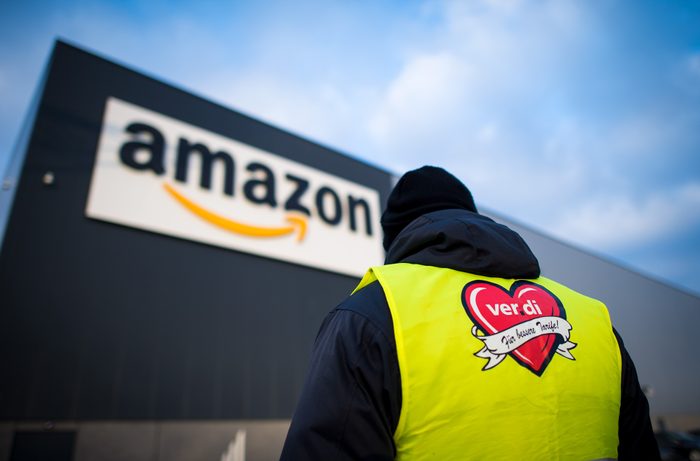
These worker actions, even if small and isolated for now at least, are threatening because they are ultimately about workers seizing control. Amazon’s model of maximizing profits at all costs depends on the total submission of its workforce, cheap labor and complete domination of the workplace.
“That kind of control is at the heart of the Amazon enterprise. The idea of surrendering it is the company’s greatest horror,” according to New York Times technology reporter David Streitfeld.
“We need more control over our work,” Zama says. “We need more say over how we do our work.”
He believes other Amazon warehouses can learn from the Chicago playbook of building up capacity to fight through small-issue campaigns, flexing their muscles to exert greater shop floor control. Through a sort of “propaganda of the deed,” workers across facilities in the United States have reached out for guidance, finding common cause with the workers in Chicago, and a shared experience of grueling working conditions.
“We’re sharing with fellow workers what we’re experiencing and how we’re resisting,” Zama says. These conversations, in turn, lead to organizing, or “guiding fellow workers [on] how to create basically their own Amazonians United at their own facility, through issue fights.”
In Queens, New York, Amazon worker Ira Pollock read news stories of Amazonians United in Chicago and Sacramento “fighting the boss to make changes in their warehouses.” Pollock and other workers formed an organizing committee and started using similar tactics, launching petitions for improvements on the job, marching on the boss to demand immediate changes, and building community to bind workers together as a fighting union. They staged two safety walkouts during the height of the pandemic and continue to organize new members.
The Queens workers were so effective that a former FBI agent attempted to intimidate and interrogate Amazon worker Jonathan Bailey, who led the walkouts.
Amazonians United has largely been focused on delivery centers — the last layover on a product’s trip from fulfillment center to customer delivery and the linchpin in Amazon’s last-mile logistics chain. Packages that arrive at a delivery station must be turned around the same day. Many are “cross-docked,” a model Amazon borrowed from Walmart, in which “goods move in one door and out another without being racked or stored,” as Kim Moody explains in The Cost of Free Shipping.
That last mile in the logistics chain represents a key site of disruption. Worker slowdowns and sabotage could throw the whole just-in-time delivery service into disarray.
“We are crucial to Amazon’s ability to deliver on its promises to its consumers,” Pollock says. “We have a decent amount of power in terms of whether or not it can fulfill those operations. So our goal is to use that power as workers to bring Amazon to the table and negotiate over our working conditions.
“We also recognize we can’t do it at just one warehouse. So we need to grow.”
The Power of a Click
Amazon has addicted its consumers to speedy fulfillment. More than 150 million people subscribe to Amazon Prime, jonesing for the convenience of one-day delivery.
One of them is former New York Times columnist Joe Nocera. In a 2008 panegyric, “Put Buyers First? What a Concept,” Nocera swoons over Amazon’s ability to deliver on-time packages Christmas Day. In a good set piece for workers to read aloud at picket lines, Nocera effusively reports on the company’s rush to replace a PlayStation 3, his son’s Christmas present, that went missing from his doorstep after delivery. He called Amazon customer service December 21, and workers delivered a “little Christmas miracle” Christmas Eve.
Let’s use Nocera’s order to illustrate how Amazon’s delivery network operates. We can follow the likely path of the PlayStation by drawing from the essays in The Cost of Free Shipping, edited by Jake Alimahomed-Wilson and Ellen Reese, which describes Amazon’s delivery process in detail.
After Nocera placed his Amazon Prime order, the delivery process kicked off at an Amazon fulfillment center, one of three basic categories of Amazon warehouses. At the fulfillment center, a worker picked the PlayStation and packed it into a box with a shipping label.
Then the box went to the next type of Amazon warehouse — a sortation center — where it was sorted. It was then transported to the third kind of Amazon warehouse, an Amazon delivery center, where the U.S. Postal Service took it the last mile to Nocera’s doorstep. Today, the package would more likely be delivered by Amazon Flex (independent contractors) or Amazon Delivery Service Partners (a third-party contractor that hires its own workers).
This delivery process relies on seamless, interlocking networks of warehouses and logistic operations.

“They’ve got to be able to fulfill these package orders to different parts of the country,” Joshua Brewer, RWDSU’s lead organizer, says about Amazon’s model. “It’s very similar to the automotive supply chains of the ’30s, ’40s and ’50s. Those [plants] couldn’t afford to have kinks.”
Back in 1936, workers at General Motors recognized the leverage they had in Flint, Mich., and Cleveland, with a sit-down strike against the world’s largest company. GM, with 250,000 workers, was “not big but colossal,” according to Fortune magazine, which described the company as “the world’s most complicated and most profitable manufacturing enterprise.”
GM plants, like Amazon warehouses, were sites of dismal working conditions. “Where you used to be a man … now you are less than their cheapest tool,” one Chevrolet worker said.
“We didn’t even have time to go to the toilet … if there wasn’t anybody to relieve you,” one Buick worker complained.
Like Amazon, GM’s power seemed supreme. But organizers with the United Auto Workers (UAW) identified a key point of leverage: a vulnerability in the supply chain in Flint and Cleveland, where GM stamped out auto bodies and parts for Chevy, Buick, Pontiac and Oldsmobile.
“We knew that if we could tie up these two shops, then General Motors would come to a halt,” said Wyndham Mortimer, a leading UAW organizer.
The six-week sit-down concluded February 11, 1937, and brought GM to the bargaining table, setting the stage for the UAW to become one of the most powerful unions in the country.
The key, then, to defeating Amazon’s oppressive work system may very well rest on chokepoints like the delivery stations, where workers are as indispensable now as the autoworkers in Flint and Cleveland were 84 years ago.
But no single delivery station has the power to bring Amazon to a halt. Coordination across the United States and globally would be necessary. Some labor experts and organizers see a more recent precedent for this kind of coordination in the solidarity actions of dock workers’ unions.
“Just as the labor movement has been successful in organizing on the waterfront by employing internationalist strategies to slow the flow of marine cargo, similar strategies can block or delay the flow of Amazon deliveries,” according to Peter Olney, retired organizing director for the International Longshore and Warehouse Union, and union organizer Rand Wilson in The Cost of Free Shipping.
A 2000 strike by longshore workers in Charleston, S.C., offers an example. International Longshoremen’s Association Local 1422 organized a picket in protest of a shipping line at the docks using non-union labor. The largely Black workforce faced off against state troopers who had helicopters and armored personnel. That battle drew support from longshore workers on the West Coast, who fundraised to free the jailed Charleston workers. And “that kind of solidarity effort caught the eyes of Spanish dockworkers,” recalls longshore worker Leonard Riley, now 68. “They said, ‘If their ships were [using] non-union labor in South Carolina, they weren’t going to unload them in Spain.’ ”
The solidarity action in Spain was decisive in the dock workers’ victory. They brought the rogue non-union shipping line back to the negotiating table.
“Charleston, South Carolina, was one of the major places that imported slaves,” Riley says, reflecting on the win. “We were once the cargo on those ships. But now we control the shipping on those ships — thanks to workers’ organizing.”
Internationalism and the disruption of delivery stations are complementary strategies. When German workers went on strike in 2013, for instance, Amazon opened three fulfillment centers across the border in Poland. To combat Amazon’s union-busting tactics, workers must leave Amazon no safe harbor to divide and exploit workers.
Delivering the Future
Sometimes, internationalism is built into the composition of the labor force itself. Just as Amazon moves around the world — threatening to conquer every node in the global supply chain and drive rivals out of business — so, too, have displaced workers moved with it. That highly mobile workforce Amazon helped create may very well lend strategic leverage for workers to unite and fight the hegemon.
Julián Andrés Marval Arrue, a native of Venezuela, began working for Amazon in 2012 in Germany as a “picker,” Amazon’s term for a warehouse worker who picks items from coded shelves and places them in a bin for shipping preparations. Marval Arrue worked alongside immigrants from Turkey, Russia, Pakistan and Poland. In Germany, he says, the workplace protections were strong and managers were forbidden from stringently enforcing productivity quotas.
But when Marval Arrue began working for Amazon in Spain in 2016, he encountered crushing workloads and abusive supervisors. One manager would “smash boxes if they weren’t prepared to his taste,” he says.
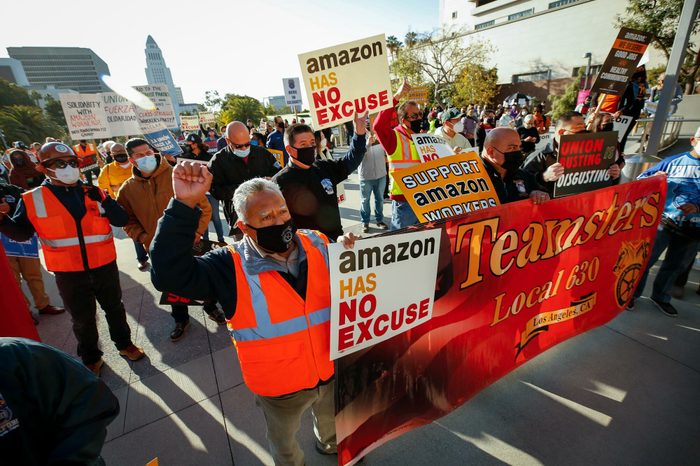
These experiences led Marval Arrue to become a union representative with Confederación Sindical de Comisiones Obreras, or Workers’ Commissions, the largest trade union in Spain. He got involved in international solidarity forums with Amazon workers across Europe and the United States.
“To hear all those stories,” Marval Arrue says, reflecting on the struggles of his U.S. counterparts. “That there were double shifts, people weren’t given masks, no temperature checks, no disinfectant gel” — these gruesome realities drove home a unifying consensus, from Spain to the United States, that “one of the most profitable companies wouldn’t care about its workers.”
“[As long] as not all Amazon warehouses are unionized … the company takes advantage of that and does whatever they want with overtime, working schedules and over-demanding productivity rates,” Marval Arrue says.
“We never have to lose sight of what we can manage if we unite.”
Luis Feliz Leon is an associate editor and organizer at Labor Notes.
